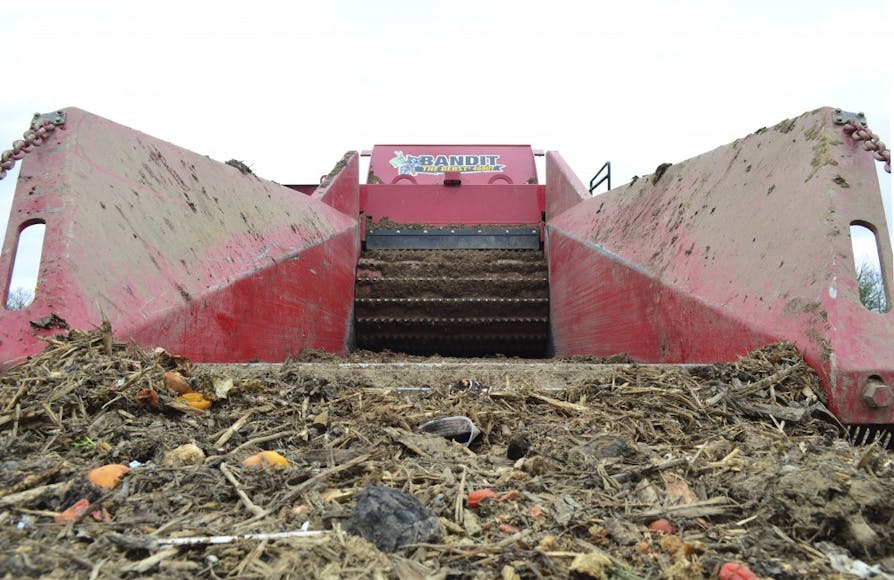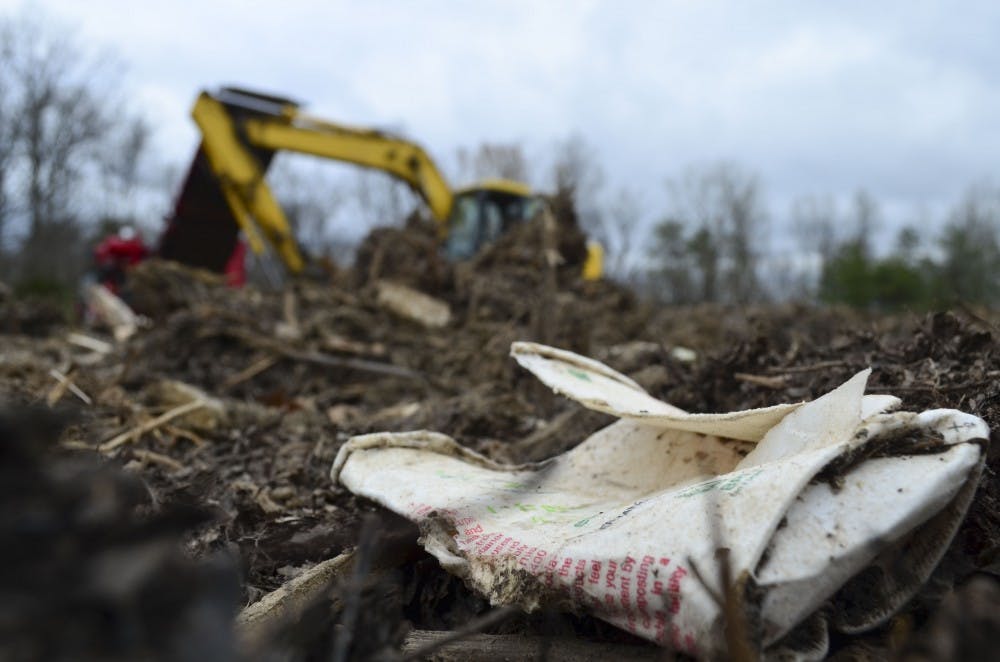It was so warm, the 15-foot mound of waste steamed in the cool morning air like a fresh pile of dog poop.
Peeking out of the mound and scattered around it are familiar reminders of campus life — an orange spoon from Bloomingberry, several compostable Coca-Cola cups and the filmy liner that cradles every order from the Stone Grill.
Every week, IU brings 10,000 pounds of compostable waste to Green Earth, a compost yard 10 miles from the Sample Gates on the west side of Bloomington.
All of the waste comes from Residential Programs and Services, IU Athletics and the Indiana Memorial Union.
Two RPS dining halls contributing to the compost pile, Goodbody Eatery and the Restaurants at Woodlands, are Zero Waste facilities. Rahul Shrivastav, director of dining services, said the halls both defer 96 percent of the waste they produce from landfills.
Shrivastav said he plans to continue converting IU’s dining halls to Zero Waste. In fall 2018, Wright Dining Hall and the Bookmarket Eatery in Herman B Wells Library will be converted as well.
What is Zero Waste?
IU’s move toward composting waste started with a compostable Coke cup. Shrivastav said when he began working at IU in July 2017, the University was doing a lot of recycling. But he knew Coca-Cola offered a compostable cup IU wasn’t using.
Shrivastav switched to the compostable Coke cup, and from there, he expanded to compostable silverware, bowls and trays. When Goodbody opened last fall, Shrivastav was able to work on building a Zero Waste facility from the start.
Zero Waste does not mean absolutely zero waste is being created. The Environmental Protection Agency does not regulate it. At IU, Zero Waste means deferring 96 percent of waste from landfills.
“There is always going to be waste that is going to go to trash,” Shrivastav said.
It’s part philosophy, part lifestyle. Shrivastav described Zero Waste in terms of “closing the loop.” Once food is properly composted, which takes between three and six months, it can be used as soil. That soil can go back into the earth to plant more food, closing the loop.
Recycling, where materials have to be turned into entirely new products, takes more time, Shrivastav said.
Woodlands has no easily accessible trash cans. Instead, students put their trash on a multi-level conveyor that whisks leftovers to a sorting area. This may help eliminate incorrect sorting by students.
At Goodbody, there’s no conveyor belt, but trash cans are labeled for landfill, compost and recycling. Almost everything at the dining hall is compostable or recyclable.
“Post-consumer sorting is where it gets complicated,” Shrivastav said. “If you're in a hurry, and if your cup is compostable and the lid is recyclable, you're not going to take the time to figure out where they go."
Josh Emerick, general manager of Goodbody and Bookmarket eateries, said the idea is to take the choice of which bin to put leftovers in out of the hands of customers by making nearly everything compostable.
Follow the food
The last bite of your Bedrock Burger from the Stone Grill or last sip of Cherry Berry smoothie from Bloomingberry isn’t done once it makes its way around the conveyor in Woodlands.
Your leftovers just might meet Linda Castledine, who has worked at IU as a custodian since 2016 and has worked in dishwashing for 13 years.
As trays, boxes, cups, bowls, silverware, napkins and other unwanted bits of trash swung their way around the conveyor, Castledine sorts between compost and recycling. She doesn't have a bin for landfill trash — at Woodlands, almost everything that comes around is either compostable or recyclable. Even the trash bags are compostable.

To save room in the bags, Castledine dumps food waste from trays and then stacks the trays together. She does the same with cups, bowls and other stackable items.
From there, the bags are taken down a hallway, through the kitchen, past the Stone Grill and behind Caliente to the loading dock. Compactors in the loading dock compress recyclables and other materials so they take up less space in the dumpster.
JB’s Salvage, a Bloomington scrap metal recycling company contracted by the University, takes the compost to Green Earth, while landfill and recyclables are picked up by a mixture of IU campus trucks and Republic Services.
For the landfill waste, that means a 63-mile drive to Terre Haute, Indiana, where it’s dumped.
IU started bringing its compost to Green Earth in March 2017, said Steve Akers, associate director of environmental operations in RPS.
Composting is more expensive than putting everything in a landfill, Akers said.
“But within that cost is the cost of air quality and methane,” Akers said. “We're keeping it in Monroe County, we're shredding it and creating soil that can be used in a much more efficient and more environmentally friendly way.”
About once a week, around 6 a.m., a truckload of food waste from JB’s Salvage arrives at Green Earth for Kevin Huntley, who runs the compost yard.
That truckload of waste is put into a bright red shredder called the Beast. Along the side of the shredder is a paint job of an anthropomorphic raccoon flexing his bicep.
When the compost is dry enough, Huntley uses a yellow Komatsu excavator to create rows of compost to spread it out.
Here, at the top of a hill nearly surrounded by forest, the piles of compost smell fresh and rotting all at once. In these mounds, the life and death of our food is simultaneous. That last bite of flatbread pizza you couldn’t muster the will to eat last week is given another chance.
A shredder comes to life, the bags of waste go into its teeth and life goes on.





